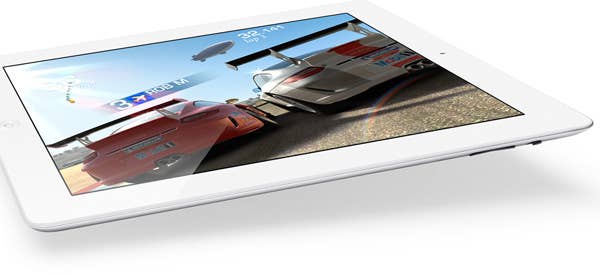Tech Focus: iPad Mini and the Fourth Gen iPad
Digital Foundry's take on the latest brace of Apple tablets
We were expecting just one new tablet launch, but in the event, we got two - one of which came out of nowhere. The reveal of the iPad Mini surprised nobody, but the unveiling of a fourth generation iPad just seven months after the reveal of its predecessor managed to escape the notice of the usually well-informed Apple rumour mill. As it happens, both launches proved to be rather controversial, each in their own way.
Pricing and positioning of the new iPad mini is curious to say the least. Just over a month ago in reaction to Apple's last event, I wondered whatever happened to the iPad Mini, suggesting that the £249/$299 iPod Touch was an excellent addition to a range that included the £329/$399 iPad 2 and the £399/$499 new iPad. Surely Apple wouldn't launch against itself with the iPad mini?
"iPad mini will undoubtedly expand Apple's market but it makes the new iPod Touch look even more pricey and the older more expensive iPad 2 now looks totally irrelevant. Meanwhile the Nexus 7 is still £80 cheaper"
In essence, that is exactly what it has done. At £269/$329, the gap between the new tablet and the fifth gen Touch is wafer-thin, and while Apple was keen to point out the advantages the mini has over the Nexus 7 during its conference, the fact is that it's £80 more expensive (£100 if you're happy with an 8GB Android). The iPad mini looks to be the superior product for all the reasons Apple came up with at the event, but the bottom line is that in acknowledging the cheap 7-inch tablets with their own version, the firm may well have helped to emphasise just how inexpensive they are in comparison - and how pricey the iPod Touch is too.
The fact that Apple is still selling the iPad 2 at £329/$399 when they have a more refined, more portable version that's significantly cheaper is equally mystifying. Looking at the specs for the new Mini, it is essentially identical to the iPad 2 in almost every way - specifically in its 1024x768 resolution display, driven by a dual-core A5 processor. Battery life is still at the signature iPad ten-hour level, storage is identical, and it features a number of other features that actually improve upon its older, more expensive counterpart - specifically the provision of the new Lightning connector and the option of a 4G LTE modem.
It's an interesting turn of events: we have a new launch that's too expensive compared to its competitors but diminishes the value proposition of the iPod touch, while at the same time it is cheap enough to condemn the old iPad 2 to irrelevancy, bearing in mind that the overall functionality of the device is effectively identical.
At least it's good news for game developers though. The range of commonalities the iPad mini has with the iPad 2 mean that existing apps will gain a new audience as more devices enter the iOS ecosphere. In addition to that, game-makers won't have to put in any R&D effort into getting to know the capabilities of the new hardware - it's very much a known quantity. There's no new resolution to support either - always a concern for game-makers whenever a new Apple device comes along. In terms of gaming power, the dual-core ARM Cortex A9s in concert with the PowerVR SGX543MP2 graphics core still commands a decent advantage over the majority of Android tablets and smartphones out there, and while it's two CPU processor cores down compared to the Nexus 7, IMG's graphics technology was so far ahead of its time when the iPad 2 launched that as a games machine, all the A5 devices - including the fifth gen iPod touch - remain competitive in demanding 3D applications.
"iPad Mini is essentially a downsized iPad 2 - good news for customers looking for a cheaper Apple tablet and excellent for developers who already know the hardware inside-out"
While the iPad Mini was the star of the show, we shouldn't forget that a second iPad was also unveiled - a fourth gen version of the classic 9.7-inch design that will be released just over seven months after its predecessor. Much as I admire the achievements in display technology found in the third gen Retina iPad, I wasn't so impressed with the compromises Apple had to make to rush the product out. A 45nm A5X processor sucked a lot of juice and got uncomfortably warm at times, and the increased battery load also required larger cells - bigger and more powerful than the batteries in the 11-inch Macbook Air. Although almost identical visually to the iPad 2, its successor was actually thicker and heavier too. It was a machine at odds with Apple's usual philosophy in providing generational leaps in mobile technology while at the same time making their devices smaller, thinner and easier to hold in the hand.
There was also the sense that the third gen iPad was simply not as well balanced as its predecessor. The GPU was twice as powerful as that found in the iPad 2, but it simply didn't have the power to run demanding games at four times the resolution level of its stable-mate, resulting in many games running at sub-native resolutions or else cutting back on effects work or operating with lower frame-rates.
The fourth gen iPad appears to address some of these issues. The new A6X processor promises to double CPU and graphics performance over the current model and should now match and probably even exceed the GPU resource vs. pixel ratio of the iPad 2. With iPhone 5, Apple has demonstrated just how much power and efficiency it can extract through its bespoke architecture fabricated via Samsung's 32nm process, so there should be no problem with the new tablet retaining the exceptional battery life that has defined the product. It is a bit of a shame that Apple's presser didn't concentrate on what the new A6X hardware is capable of though. Assuming the claims are true, a 2x graphics boost over the third-gen iPad makes the A6X by far the most powerful mobile graphics processor on the market - easily out-pacing iPhone 5 - and I'd like to have seen that fact highlighted and some grand new apps revealed to showcase that.

Perhaps the reason we didn't see the firm dwell too much on the fourth-gen iPad is down to the fact that it's arrived way too soon. We've been conditioned to accept that our devices will be upgraded annually, something that's already difficult to swallow when you're dealing with £400-£600 pieces of hardware. With so many mobile telephones replaced on contract, it's easier to absorb the pain with the iPhone across monthly payments, but iPad is a completely different story. For Apple to have replaced - and indeed discontinued - the third gen model in mere months is going to be very difficult for many customers to accept. Many people will be asking why Apple has risked invoking consumer wrath in this manner - a couple of explanations spring to mind.
"If the annual product refresh has now been reset to September/October, we can assume that iPhone gets the new processing tech first, with a customised tablet variant arriving very soon after"
The obvious conclusion is that we're looking at the company moving across to a new engineering strategy. Previously, iPad would be the first product to receive Apple's latest processor, with the new iPhone receiving a downclocked version of the same chip six months later. Now it is clear that the emphasis has changed: if the annual refresh has now been reset to September/October, we can assume that iPhone gets the new processing tech first, with a customised tablet variant arriving very soon after.
The extent of that customisation is intriguing: in terms of raw GPU power, iPhone 5 manages to outperform the third gen iPad, but it's a close battle. For the new tablet to offer so much more graphical power than its predecessor strongly suggests that A6X offers more GPU cores and perhaps a boost to clock speed too in comparison to the iPhone 5. Perhaps it's an acceptance from Apple of the reality that running a 2048x1536 display requires far more processing power than that allocated to the 1136x640 screen found in iPhone 5.
Resetting the annual refresh clock also affords Apple some breathing space in preparing for the arrival of the mobile parts designed with 28nm fabrication in mind. The A6 and presumably the A6X both feature customised ARM Cortex A9 CPU cores with PowerVR SGX543 graphics - but the future is all about ARM's A15 core and PowerVR Rogue, which if well-informed sources are to be believed, will finally see Xbox 360-level GPU power make its way to mobile platforms. Rogue was originally planned to debut in SoCs arriving in Q4 this year - Sony's new NovaThor platform for one - but it now seems far more likely that it will arrive towards the end of H1 in 2013. Bearing in mind the millions of units Apple has to fabricate to accommodate both iPhone and iPad, moving the tablet into line with the phone's launch window in Q4 makes a whole lot of sense - not to mention allowing it to capitalise more effectively on the holiday season spending season.
It's an effective, logical business decision for Apple, but at the same time the fact that the third gen iPad was released at all demonstrates clearly that the company's products are now profit, rather than design-focused. The A6 and A6X would have been completed from an engineering perspective back in March: Apple launched the "new iPad" knowing that its A5X processor wasn't entirely up to the task, and that the A6X would be available soon after. It launched a product for £399/$499 that was merely "good enough" but obviously not the best that it could possibly be. Bearing in mind Steve Jobs' obsessive quest for the very best user-experience, it's hard to believe that he would have allowed this to happen on his watch.

